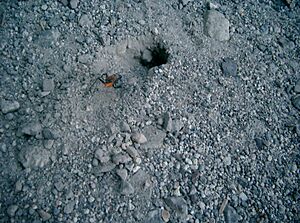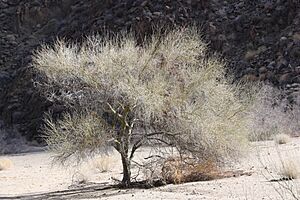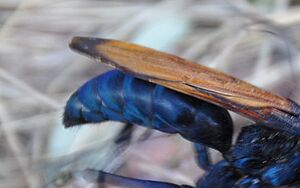Hemipepsis ustulata facts for kids
Quick facts for kids Hemipepsis ustulata |
|
|---|---|
| Conservation status | |
| Scientific classification | |
| Synonyms | |
|
The Hemipepsis ustulata is a type of tarantula hawk wasp. It lives in the Southwestern United States. These wasps are large and have long legs. They hunt tarantulas. They use their legs to grab their prey. Then, they sting the tarantula to make it paralyzed. Their sting is one of the most painful in the insect world. These wasps live alone. Males gather in special areas to find mates.
Contents
About the Wasp
H. ustulata wasps are usually dull black. They have rust-orange wings. They are among the largest Hymenoptera insects. They can grow up to 5 cm long. It can be hard to tell Hemipepsis wasps apart from their relatives, Pepsis wasps. Pepsis wasps are often more metallic black. They also have deep-blue stripes. Their bodies and looks are very similar. The best way to tell them apart is by looking at the patterns of their wing veins.
Where They Live
H. ustulata wasps are common in the dry areas of the Southwestern United States. They live from California to Arizona, New Mexico, and Texas. They can also be found as far north as Nevada, Oklahoma, and Kansas. Much research on these wasps was done in the Sonoran Desert. This was near Phoenix, Arizona, by John Alcock. The areas where H. ustulata lives overlap with tarantulas. This is because the wasps use tarantulas to raise their young.
Life Cycle
How They Use Tarantulas
Tarantula hawk wasps get their name because they hunt tarantulas. They do this to feed their young. After mating, the female wasp looks for a tarantula. It might be out in the open or in its burrow. The wasp grabs the tarantula. Then, she gives it a powerful sting. This sting paralyzes the tarantula forever. But it keeps the tarantula alive. This lets the wasp lay an egg on the spider's belly. One tarantula is used for each egg. The egg is about 5 mm long. It is slightly curved and creamy white.
The wasp then drags the paralyzed tarantula and egg. Sometimes, she drags it up to 100 meters. She takes it to a hole or burrow. This hole can be one the wasp dug. Or it can be the tarantula's own burrow. The wasp then seals the hole. When the larva hatches, it eats the spider's insides. It keeps the spider alive as long as possible. This makes sure the food stays fresh.
Larva Stage
About three days after the egg is laid, one end of the egg turns clear white. The tiny grub chews its way out. It uses its small, dark-tipped mandibles. Soon, the eggshell splits open. A shiny, white, footless grub appears. The grub is still attached to the tarantula by its tail. It arches over and digs into the tarantula's skin. It makes a hole with the help of a special fluid.
Now, the grub is firmly attached to the tarantula. It starts to suck the juices from the tarantula's body. As it eats, the larva grows. It quickly gets bigger from eating the tarantula. Its color also gets darker. As it grows, it sheds its skin several times. After each shed, it starts eating again. It often makes a new hole. By its fourth stage, the tarantula's belly has shrunk a bit. In the fifth and last stage, the larva has strong, three-toothed mandibles. This helps it keep up with its eating. The larva becomes strong and can move around. It cuts a hole into the tarantula's hard outer shell. It pushes its head and chest inside the spider. It keeps eating a lot. As it eats, it hollows out the tarantula. It eats up to the bases of the spider's hairy legs. At the start of this attack, the tarantula finally dies. This whole process, from egg to fifth stage, takes about 35 days.
Cocoon and Pupa Stages
The well-fed grub starts to spin a delicate frame. This frame will hold its cocoon. The Hemipepsis cocoon is a brown, silk structure. It is a bit wider at the end where the wasp will come out. The inside wall is shiny. There is no inner cocoon. It takes several hours to finish the cocoon. After it's done, the grub empties its alimentary canal. This first waste becomes a hard mass at the end of the cocoon. The grub is much smaller now. This is because it used a lot of its body to spin the cocoon and get rid of waste. The cocoon changes from silky gray to a greasy amber yellow.
When the wasp hatches depends on the season. A cocoon made in early summer might hatch that same summer. But one made in late summer or autumn might stay in cocoon form. It could stay like that until the next spring or summer. Once the grub reaches the pupa stage, it lies still. The head splits open. A clear, whitish pupa pushes its way out of the old larval skin. The pupa turns creamy yellow. Its large, gray-blue eyes show through its thin skin. You can also see its antennae, small wing pads, and back spines.
Emerging from the Cocoon
As the wasp inside grows, the pupa gets darker. You can hear a sharp scratching noise. This is the young wasp cutting its way out of the tough cocoon. It uses its strong mandibles. The empty cocoon holds the remains of the larval skin, pupal skin, and waste. The young wasp then digs its way out of its underground cell.
Behavior
Reproduction
The breeding season for H. ustulata lasts about two and a half months. Male wasps actively look for mates on mountain ridges. They do this for up to three weeks at a time. Many males live for more than one month.
Communication
We don't fully know how these wasps talk to each other. This is especially true when they gather in groups. But their strong smells, flight patterns, and bright colors likely help them communicate.
Mating Behavior
Male wasps often choose palo verde trees as special spots. These spots are usually higher up on mountain ridges. During the male flight season, who owns these spots changes a lot. A male usually stays in a spot for about 8 days. They fight in the air to claim these spots. Bigger males usually win. They push smaller males out of the best spots during mating season. Many males are present during this time. Females are rarely seen. So, there are many more males than females.
In some ways, the mating system of H. ustulata is like a "lek." In insects that go hilltopping, the male defends a territory. Females might visit these spots. But they only stay long enough to mate. They do not nest or feed there. In a lekking species, the male's territory does not offer resources for females. These resources could be food, shelter, or good nesting sites. Other signs of H. ustulata's lekking behavior include a mating area. Here, males gather year after year. Each male protects his own spot. Females choose their mates after checking out the males in their spots.
Favorite Spots
The tarantula hawk wasp returns to the same important plants. These are usually palo verde trees (Cercidium microphyllum). They do this year after year during mating season. The best spots on a mountain ridge stay very consistent. This happens from one generation to the next. It seems that males who can get the best spots have better access to females.
Size Differences
Often in nature, a larger body size helps an animal reproduce better. So, why do smaller H. ustulata wasps still exist? There is a wide range of sizes among these tarantula hawks. Wasps do not grow after metamorphosis. So, smaller wasps are always at a disadvantage when competing. John Alcock's studies show how important size is for male H. ustulata wasps. It affects their ability to claim good territories.
How the mother wasp feeds her young might explain these size differences. The size of the baby wasp depends on how much the mother invests in it. The size of the tarantula the mother catches decides how big the larva will get. Catching a larger tarantula takes more energy. It also puts the mother wasp at greater risk. If the baby is a large male, it would need to be twice as strong as a smaller male. This is to make up for the mother's effort. So, sometimes, it might be better for the mother wasp to have many small male babies. This way, they can be just as successful as a female. But they have fewer, larger offspring.
Defending Territory
Male wasps that own territory sit on tall plants. These are usually on high mountains (1500 m or higher). They chase away any other wasps that come near. Only one wasp usually stays in a territory for more than a few minutes. The male wasp that owns the land often takes short, regular flights from his spot. Other wasps often visit these spots. Males compete for the best territory. Sometimes, a visiting wasp will fight the owner in the air. They fight over who gets to use the tree or bush. The two males hit wings and spiral upwards. They are fighting for the territory.
What They Eat and Who Eats Them
Diet
H. ustulata larvae eat tarantulas. The adult wasps paralyze and capture these tarantulas. Adult wasps spend a lot of time flying around. They actively search for prey on the ground. Adult wasps also eat nectar. They visit flowers and flowering plants during the day. Some popular nectar sources include milkweeds (Asclepias) and western soapberry trees (Sapindus saponaria).
Predators
The very painful sting of H. ustulata keeps almost all predators away. We don't know of any amphibians, reptiles, or mammals that eat adult tarantula hawks. The only known cases of tarantula hawk predation were by kingbirds in Puerto Rico. A scientist named Dr. Punzo saw two cases of roadrunners attacking wasps on the ground. But it's not known if those wasps were healthy. It's also not known if they were male or female. Cases of roadrunners eating them are very rare. This is true even for harmless males. This shows how well tarantula hawks can defend themselves. It also shows their strong reputation in the animal kingdom.
Defense
Body Armor
Tarantula hawks are great examples of how insects can defend themselves. Justin Schmidt, a leading expert, says they are "aposematic." This means they have warning colors. They also have strong smells. Their bodies are covered in hard, smooth, and slippery armor. They live a long time. They form groups to warn others. They even have sharp leg spines for defense. They are truly some of the best-defended insects on Earth.
Stories of battles between tarantula hawks and tarantulas show their defensive strength. Even when caught in the jaws of one of the largest and strongest spiders, the tarantula hawk almost always escapes unharmed. During their fights, you can often hear loud crunching sounds. This is the tarantula trying to crush the wasp. One study recorded no wasp deaths in 200 tarantula fights. Another study saw only one wasp injury in many field observations. Their strong, slippery armor lets the wasp slip away safely.
Venom
The tarantula hawk's venom causes a lot of pain. It's described as blinding and shocking. But this pain goes away in only three minutes in humans. Only the bullet ant's sting is ranked higher. How can a venom that causes so much pain not be very toxic? And how does it permanently paralyze a tarantula, but keep it alive? It's interesting how such a special venom evolved.
Animals that might eat the wasp would learn to avoid those with painful venom. But it wouldn't be good if the venom killed the prey. Then the prey would spoil. So, the tarantula hawk's venom is a special mix of chemicals. It's perfectly suited for the wasp's needs. Studying this venom might help us understand how to treat human problems. This includes long-lasting pain from injuries or diseases.
Warning Colors and Smell
H. ustulata and other tarantula hawks are known for their warning colors. They can be shiny black to blue-black. They have bright yellow, orange, or red wings. These are classic warning colors. They tell experienced predators to stay away. They also make new predators careful. Tarantula hawks also give off a warning smell. This smell keeps predators away. Such a bad smell, along with a very painful sting, makes a strong impression on predators. It keeps them from attacking.
Mimicry
All tarantula hawks are protected by their similar colors. Female tarantula hawks help each other. Their painful stings teach predators to stay away. Male tarantula hawks cannot sting. But they are protected because they look like females. Other species also gain protection by copying tarantula hawks. This can be Müllerian mimicry or Batesian mimicry. The strength of this mimicry shows how powerful the Hemipepsis sting is.
Gathering in Groups
When hunting tarantulas is not easy, these wasps gather in groups. This helps them both for defense and finding food. Having many wasps together makes the warning signal stronger. It tells predators to stay away. Also, being in a large group means each wasp is less likely to be attacked. Besides defense, these groups also help wasps find nectar. They also create more chances for mating.
Images for kids





